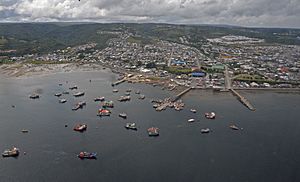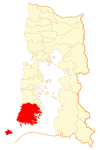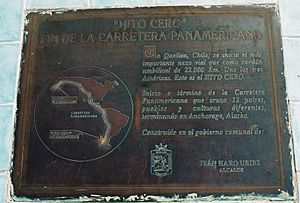Quellón facts for kids
Quick facts for kids
Quellón
|
|||||
|---|---|---|---|---|---|

Aerial view of Quellón by 2016
|
|||||
|
|||||
| Country | Chile | ||||
| Region | Los Lagos | ||||
| Province | Chiloé | ||||
| Founded | 1905 | ||||
| Founded as | Llauquil | ||||
| Government | |||||
| • Type | Municipality | ||||
| Area | |||||
| • Total | 3,244.0 km2 (1,252.5 sq mi) | ||||
| Elevation | 5 m (16 ft) | ||||
| Population
(2002 Census)
|
|||||
| • Total | 23,992 | ||||
| • Density | 7.39581/km2 (19.1551/sq mi) | ||||
| • Urban | 13,656 | ||||
| • Rural | 8,167 | ||||
| Demonym(s) | Quellonino | ||||
| Sex | |||||
| • Men | 11,595 | ||||
| • Women | 10,228 | ||||
| Time zone | UTC−4 (CLT) | ||||
| • Summer (DST) | UTC−3 (CLST) | ||||
| Area code(s) | 56 + 65 | ||||
Quellón is a port city and commune in Chile. It is located in the Chiloé Province, at the southern end of Chiloé Island in the Los Lagos Region. Quellón is famous for being one of the final stops of the Panamerican Highway and the Pacific Coast Highway.
This city is a very important center for aquaculture (farming seafood) and fishing. Many people here work on small fishing boats called "lanchas" for days. Others work in local factories that process seafood. Quellón also connects to other places in Patagonia by ferry, like Melinka and Puerto Cisnes.
Contents
Understanding Quellón's Weather
Quellón has an oceanic climate, which means it has cool, wet winters and mild summers. It's often windy here, especially from the west.
Winter Weather in Quellón
Winters are cool and rainy. From June to August, it rains a lot, usually between 208 to 261 millimeters (about 8 to 10 inches) each month. The air is also very humid, around 85–87%. It rains almost every day, with about 22–24 rainy days each month. Snowfall is very rare. The average temperature in July is about 7.7°C (45.9°F).
Summer Weather in Quellón
Summers are mild, with an average temperature of 15.1°C (59.2°F) in January. It rains less during summer, with February being the driest month, getting about 103.3 millimeters (4 inches) of rain. Sometimes, temperatures can go above 20°C (68°F) between September and June.
Temperature Records in Quellón
The highest temperature ever recorded in Quellón was 32.5°C (90.5°F) in January 1978. The lowest temperature was -4.4°C (24.1°F), recorded in June 1971 and August 1975. On average, Quellón gets about 1960.6 millimeters (77.2 inches) of rain each year.
| Climate data for Quellón | |||||||||||||
|---|---|---|---|---|---|---|---|---|---|---|---|---|---|
| Month | Jan | Feb | Mar | Apr | May | Jun | Jul | Aug | Sep | Oct | Nov | Dec | Year |
| Record high °C (°F) | 32.5 (90.5) |
26.4 (79.5) |
24.6 (76.3) |
27.6 (81.7) |
19.8 (67.6) |
19.0 (66.2) |
22.5 (72.5) |
19.7 (67.5) |
23.2 (73.8) |
22.5 (72.5) |
25.6 (78.1) |
25.8 (78.4) |
32.5 (90.5) |
| Mean daily maximum °C (°F) | 17.8 (64.0) |
17.6 (63.7) |
16.2 (61.2) |
14.0 (57.2) |
12.0 (53.6) |
10.1 (50.2) |
9.7 (49.5) |
10.4 (50.7) |
11.8 (53.2) |
13.5 (56.3) |
15.2 (59.4) |
16.8 (62.2) |
13.7 (56.7) |
| Daily mean °C (°F) | 15.1 (59.2) |
14.9 (58.8) |
13.6 (56.5) |
11.6 (52.9) |
9.9 (49.8) |
8.1 (46.6) |
7.7 (45.9) |
8.3 (46.9) |
9.4 (48.9) |
11.0 (51.8) |
12.6 (54.7) |
14.2 (57.6) |
11.3 (52.3) |
| Mean daily minimum °C (°F) | 11.5 (52.7) |
11.1 (52.0) |
10.0 (50.0) |
8.5 (47.3) |
7.5 (45.5) |
5.9 (42.6) |
5.4 (41.7) |
5.5 (41.9) |
6.2 (43.2) |
7.3 (45.1) |
8.9 (48.0) |
10.6 (51.1) |
8.2 (46.8) |
| Record low °C (°F) | 0.6 (33.1) |
0.9 (33.6) |
0.7 (33.3) |
0.3 (32.5) |
0.0 (32.0) |
−4.4 (24.1) |
−1.9 (28.6) |
−4.4 (24.1) |
−1.0 (30.2) |
0.0 (32.0) |
0.1 (32.2) |
0.7 (33.3) |
−4.4 (24.1) |
| Average precipitation mm (inches) | 110.9 (4.37) |
103.3 (4.07) |
106.7 (4.20) |
158.6 (6.24) |
245.0 (9.65) |
264.1 (10.40) |
237.6 (9.35) |
208.1 (8.19) |
174.6 (6.87) |
129.1 (5.08) |
116.2 (4.57) |
106.4 (4.19) |
1,960.6 (77.18) |
| Average precipitation days | 17 | 14 | 17 | 20 | 24 | 23 | 22 | 24 | 21 | 20 | 19 | 18 | 239 |
| Average relative humidity (%) | 77 | 78 | 81 | 84 | 88 | 88 | 87 | 85 | 82 | 80 | 77 | 77 | 82 |
| Source: Dirección Meteorológica de Chile | |||||||||||||
People and Population
In 2002, a study showed that Quellón had 21,823 people living there. More than half of them (13,656 people) lived in the city, while 8,167 lived in the countryside. The population of Quellón grew a lot between 1992 and 2002, by about 45%!
How Quellón is Governed
Quellón is run by a municipal council and a leader called an alcalde (mayor). The mayor is chosen by the people every four years. From 2008 to 2012, the mayor was Iván Haro Uribe.
Quellón is also part of a larger area for choosing representatives in the Chilean government. It helps elect people to the Chamber of Deputies and the Senate.
Travel and Transportation
Quellón is famous for being the southern end of the Pan-American Highway. This is a huge network of roads that stretches over 47,958 kilometers (about 29,800 miles) through 19 countries in the Americas. Its northern end is in Anchorage, Alaska. Another endpoint is in Tierra del Fuego National Park in Argentina.
Quellón is also the southern end of the Pacific Coastal Highway. This road goes for 15,202 kilometers (about 9,446 miles) all the way from Lund, British Columbia. It's hard to travel by road to the very southern parts of Chile because of the mountains and fjords.
If you want to fly, Mocopulli Airport on Chiloe Island offers flights to Santiago with LAN Express airlines.
Places to Visit in Quellón
Quellón has interesting places to explore:
Museums in Quellón
- The Museo Inchin Cuivi Anti (which means "Our ancestors") teaches visitors about the history and culture of the Huilliche people.
- The Municipal Museum (Museo Municipal) tells the story of the town of Quellón.
- The Cultural Center of Quellón was built with help from the salmon processing industry.
Markets and Waterfront Views
- The Feria Artesanal Llauquil is a market where you can find local crafts.
- The Costanera P. Montt is a marine drive that offers beautiful views of the coast.
Nearby Villages to Explore
There are several charming villages close to Quellón:
- Punta de Lapa is just 5 kilometers (about 3 miles) away and has a lovely 5-kilometer long beach.
- Compu is about 25 kilometers (about 15 miles) north and has a wooden church built in the early 1900s.
- Quellón Viejo is 4 kilometers (about 2.5 miles) southwest. It's older than Quellón and has an interesting cemetery and a typical wooden church from the early 1900s.
- Yaldad is 11 kilometers (about 7 miles) west. It's a Huilliche village with about 500 people (in 2002) and a wooden church called Iglesia Jesús de Nazareno. This church was built in the early 1900s and fixed up in 1990.
- Trincao is 10 kilometers (about 6 miles) southwest and has a cemetery and a church from 1920 worth seeing.
Images for kids
See also
 In Spanish: Quellón (comuna) para niños
In Spanish: Quellón (comuna) para niños










